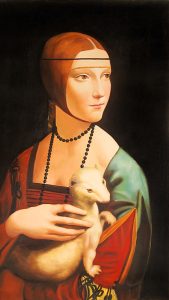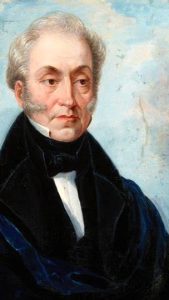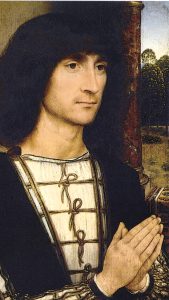



Meeting Benches is a virtual meeting and inspirational place for travelers, artists, thinkers and dreamers from all over the world. Here, virtual “benches” act as a connection point, creating an atmosphere of sharing and inspiration that allows people to share art, travel stories and thoughts. You can find articles about emerging and established artists, art galleries, poems, stories and much more. In essence, it is a digital refuge for those who love art and creativity. Meeting Benches stands out from other art blogs for its unique and poetic nature, in fact, it embraces art in all its forms. Among the artists featured on the platform, one in particular, “Lady with an Ermine” by Leonardo da Vinci, has immortalized the purity and incorruptibility of a young woman. Type in “Painters“, if you want to know more.


Around 1800, this masterpiece by Leonardo da Vinci was brought to Poland by Prince Adam Jerzy Czartoryski, who incorporated it into his family collection. During World War II, the painting was in Wawel Castle, Poland; fortunately, “Lady with an Ermine” survived the bombings. Since 2016, when the Czartoryski princes’ foundation sold the famous painting to the Polish government, the work has been exhibited at the Czartoryski Museum in Krakow, where it continues to enchant viewers, both for its beauty and its troubled history. The famous painting “Lady with an Ermine”, created by Leonardo for Ludovico Maria Sforza around 1490, represents the latter’s lover, as well as the meeting between beauty and mystery, between passion and virtue, a secret that only Leonardo knew.


The Italian nobleman and ruler of the Duchy of Milan, known as Ludovico il Moro, played a significant role in the culture of Italy at the time. A lover of the arts and culture, Ludovico was a patron of artists and intellectuals during his reign; his court, in fact, became a center of Renaissance creativity. When the death of his wife, Beatrice d’Este, sent him into a depression, his life transformed from a joyful paradise to a gloomy place. Yet this patron of the arts left us an enduring artistic legacy: a painting in which Leonardo da Vinci captured the intense expression on the face of the young Cecilia Gallerani, depicted in three-quarters, with her face turned toward the viewer. The ermine she holds in her arms, a symbol of purity and incorruptibility, is an extraordinary example of the painter’s artistic talent.
In 1482, when the thirty-year-old Leonardo da Vinci visited Milan, he sent a letter to the Duke of Milan, outlining his abilities to contribute to both public and private projects. Ludovico il Moro hired Leonardo as a director, set designer, and costume designer for elaborate parties and events. Under Ludovico’s patronage, Leonardo worked on a variety of projects, including paintings, sculptures, and architectural designs. Ludovico il Moro’s court became a center of artistic brilliance, and Leonardo da Vinci’s contributions played a pivotal role in this vibrant period. Ludovico and Leonardo’s collaboration left a lasting impact on art and science. Despite political upheavals, their partnership remains a testament to the intersection of art and power during the Renaissance.
During his stay in Milan, Leonardo da Vinci created “The Last Supper,” an iconic mural renowned for its composition, emotional depth, and mastery of perspective. A collection of Leonardo’s scientific and technical drawings, notes, and sketches, the “Codex Atlanticus,” still preserved in Milan, covers a wide range of subjects and inventions. Another of Leonardo’s notebooks, the “Codex Trivulziano,” containing various studies and observations, provides insights into his scientific and artistic explorations. Although no longer in Milan, a portrait created during Leonardo’s time there showcases Leonardo’s skill in capturing both the likeness of the model and the symbolic meaning of the ermine. “Lady with an Ermine,” depicts Cecilia Gallerani holding an ermine.
An important event, linking Ludovico il Moro to this work, occurred when he was awarded the title of knight of the Order of the Ermine by the King of Naples. The choice to depict Cecilia with an ermine, a small white animal, has symbolic meanings: the ermine represents purity and incorruptibility. The intense expression of Cecilia’s face and the attention to detail make this painting a masterpiece of Renaissance art. The work is an extraordinary example of Leonardo’s talent during his stay in Milan. Ludovico il Moro greatly appreciated that portrait, in fact, the work was a gift for him, since Cecilia Gallerani was his lover. The refinement of the details and the intense expression of Cecilia’s face struck Ludovico, demonstrating Leonardo da Vinci’s extraordinary talent. This portrait has become one of the most famous masterpieces of the Italian Renaissance.
In the fascinating painting “Lady with an Ermine” there are some interesting curiosities, even the three-dimensional perspective approach makes the figure of the lady more realistic. The ermine that the girl holds in her arms, a small white animal was often associated with nobility and virtue, is a symbol of purity and incorruptibility. Regarding the position of the animal placed near the lady’s neck, some art critics believe that it represents Cecilia’s loyalty to Ludovico il Moro; others, however, associate it with passionate love. Leonardo da Vinci rendered Cecilia’s facial expression in an extraordinary way: it is impossible not to grasp the intensity of her gaze and the delicacy of the nuances. It is impossible not to realize that, as in the portrait of “Mona Lisa“, even in Cecilia’s smile there seems to be an enigma. The life of Cecilia Gallerani, who had a son by Ludovico, is shrouded in mystery and romance, but her memory is perpetuated in Leonardo’s portrait.
Poetry and Culture of the French Pacific Islands You’re intrigued by the idea of an…
A Journey Where Wisdom Comes from Listening, Not Speaking The Indigenous Peoples of North America…
Passion and Tragedy in Shakespeare's Verona The desire to escape from the everyday and take…
Provence Trip, Inspiration for All Beauty Lovers "Sometimes you leave to forget, other times to…
When originality feeds on contamination Taking on different meanings depending on the context in which…
The Ermine, a Powerful Symbol Capable of Evoking Deep Meanings in Art and Collective Psychology…
This website uses cookies.